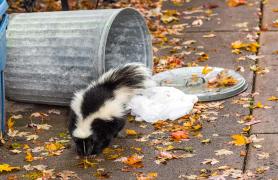Do you say, “Wow!” when you spot a whitetail? Deer are fun to watch. But many years ago, people had taken almost all of Missouri’s deer to eat and to sell.
Today, thanks to the Missouri Department of Conservation (aka MDC) and people just like you, there are lots of deer and other kinds of critters in our state.
Let’s take a look at seven kinds of wildlife that have made a strong comeback.
White-tailed deer
There are more than a million whitetails in Missouri. But back in 1925, only about 400 remained in the whole state. To protect these few survivors, MDC made it illegal to hunt them. Conservation agents also brought in deer from other states. By 1944, the herd had grown to 15,000. MDC reopened the hunting season, this time with strong rules. When you see a white-tailed deer, remember that it was once nearly as rare in Missouri as a unicorn.
Ducks, Geese and Other Waterfowl
When you hear geese honking overhead, you know spring or fall is on its way. But Missouri nearly lost the sounds of migrating geese. One reason was the widespread loss of our continent’s wetlands. These are marshy places that water-loving birds need to survive. In 1989, the North American Wetlands Conservation Act encouraged people to restore their historic wetlands. Also, breeding programs helped waterfowl grow their numbers. Today, hunters and birdwatchers alike flock to our wetlands, where millions of migrating ducks, geese, and shorebirds stop to feed and rest.
Wild Turkey
When settlers came to Missouri, they didn’t even bother raising turkeys for the dinner table — wild ones were so plentiful! But by the early 1950s, people had gobbled up all but about 2,500 of Missouri’s wild turkeys. To bring them back, MDC bought a large area in the Ozarks, where a few turkeys still strutted. Turkeys were trapped there and released throughout the state. Today, you can expect to see wild turkeys in all of Missouri’s counties, maybe even in your yard!
Boy turkeys perform fancy displays for girl turkeys. They spread their tails like a peacock and puff out their feathers. Bug-hungry baby turkeys leave the nest soon after hatching.
Peregrine Falcon
Missouri’s fastest flyer disappeared from Missouri in the mid-1900s. Pesticides had poisoned its food and weakened its eggs. With a chemical ban and artificial nest boxes in place, falconers and biologists helped return falcons to Missouri and other places where they had disappeared.Now, you can see peregrines raise their young on two Missouri web cameras. Watch them at short.mdc.mo.gov/ZZJ.
During its breath-taking dive from heights of over half a mile, the peregrine can reach speeds of 200 mph as it drops toward its prey.
Elk
These big browsers once roamed throughout most of North America. But by the late 1800s, Missouri’s elk had disappeared into people’s stewpots. In 2011, MDC began bringing in elk from Kentucky. Today, the Missouri elk herd is about 170 animals strong and growing every year. If you visit Peck Ranch Conservation Area in Carter and Shannon counties, you might see and hear them for yourself.
Elk like to communicate. In the fall, boy elk “bugle” to warn rivals and attract mates. Elk even emit a knuckle cracking sound with their front legs to signal others when a herd is moving through dense woods.
Bald Eagle
Did you know America adopted the bald eagle as its national symbol in 1782? Sadly, this big bird of prey wasn’t strong enough to survive habitat loss and pesticides. These chemicals poisoned their food and weakened their eggs, making it nearly impossible for healthy chicks to hatch. By 1963, with only 487 nesting pairs of bald eagles left, the United States listed the bird as endangered. Protected from harm and with breeding programs and restored wetlands, the bald eagle slowly recovered. Now, you regularly see them soaring along Missouri’s waterways, especially in winter.
Black Bear
Unless you live in the Ozarks, you probably haven’t seen many bears in Missouri. But they were once fairly common across the state. Settlers hunted them for their meat, fat, and hides. By the early 1900s, black bears disappeared from Missouri. Over the last 40 years, however, black bears have reappeared in Missouri’s Ozarks. Researchers think a small group may have survived there all along and are tracking the bear’s reappearance. They’re also helping everyone get used to the idea of having bears in our state again.
Helping Habitat Helps Wildlife
Wildlife needs habitat — the right kind of space, shelter, food, and water — to feel safe and secure. You can’t expect to see all Missouri’s wild critters where you live. But you can help your local wildlife keep winning the fight for survival.
- Don’t litter and help clean up trash, especially when you hike or float. Litter hurts wildlife.
- Don’t dump your bait or unwanted aquarium pets. Releasing nonnative fish, frogs,
- and other critters into the water can hurt Missouri’s native animals.
- Make room for wildlife in your yard. Birds and butterflies need native flowers, shrubs, and trees. Frogs, toads, and turtles like a little wild area with some water, if possible. Bunnies will use an out-of-the-way brush pile, and squirrels need nut-bearing trees like oaks, hickories, walnuts, and pecans.






Also In This Issue

This Issue's Staff
Les Fortenberry
Karen Hudson
Angie Daly Morfeld
Noppadol Paothong
Marci Porter
Mark Raithel
Laura Scheuler
Matt Seek
David Stonner
Nichole LeClair Terrill
Stephanie Thurber
Cliff White






















